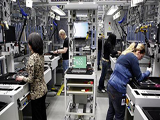The Return Of Factory Jobs Herald Brighter Times Ahead
Post Views 1
A worker Mr.Bink, who has been working at the factory for 33 years, is optimistic that “more will follow”. “They are making a lot of capital investment; buying a lot of new equipment,” he said. “That will create more jobs.”
Across the country, manufacturing factories have added 400,000 jobs in the last two years. About one fifth of the jobs lost during the recession were regained. Jobs that one felt were lost forever, are being brought back into the country by companies that include the likes of Otis and General Electric.
Hopeful that this promise of a new awakening for factory jobs , could give a boost to his re-election chances this November, the President has proposed tax-breaks and incentives to provide the catalyst boost to the movement and usher in a ‘new golden age for factory jobs.’
US lost a lot of jobs to China but there seems to be a reversal of the trend. Rising Costs in China, workers salaries, which earlier were a pittance compared to US standards, are rising at a double digit pace, increasing cost of freight and the currency gain against the dollar, is making it more and more impracticable for companies to get their goods produced in China and more attractive to manufacture them here at home.
Thirty years ago China manufactured very little of anything, but after joining World Trade Organization in 2001, China gained nearly 40 million factory jobs. US was not the only country to lose jobs, it was a phenomena across the world. According to the United Nations Industrial Development Organization, “Germany lost more than a fifth of its factory jobs from 1991 to 2007, about the same share as the United States. Japan — the manufacturing behemoth of the 1980s — lost a third.”
Those companies across the world, that shed jobs, invested in labor-saving technology owing to which efficiency increased and more goods were manufactured. Today the Master Lock Company is producing more products, than it did 15 years ago, that too with a lesser number of workers.
However, to call this a revolution in manufacturing is stretching it a bit too far. It is on an incline, but those jobs that are gone are gone for good. Gone because the employer started producing the goods in China, or gone because machines have reduced the need for human labor.
The Return Of Factory Jobs Herald Brighter Times Ahead by Harrison Barnes



 How to Succeed at a New Job
How to Succeed at a New Job  What is a Quarter-Life Crisis and How to Tackle It
What is a Quarter-Life Crisis and How to Tackle It  How to Make That First Job Worthwhile
How to Make That First Job Worthwhile  What Should You Do Once You Receive a Job Offer?
What Should You Do Once You Receive a Job Offer?  9 Tips to Help You Prepare to Work Abroad
9 Tips to Help You Prepare to Work Abroad